The iPhone 7 and iPhone 7 Plus Review: Iterating on a Flagship
by Joshua Ho & Brandon Chester on October 10, 2016 8:00 AM EST- Posted in
- Smartphones
- Apple
- Mobile
- iOS
- iOS 10
- iPhone 7
- iPhone 7 Plus
System Performance
Section by Brandon Chester
At the heart of a smartphone lies the SoC. While there's now an increasingly common belief that specifications don't matter, the truth of the matter is that almost all of the software features that users now take for granted in a smartphone have only been made possible by the continued improvements in hardware performance. Modern smartphones with high resolution displays and complex interfaces would not exist if the available CPU and GPU processing power hadn't advanced as much as it has. On top of that, performance is something of a gating factor for software development, as the innovation that happens in software has to happen within the boundaries of what can be done with the hardware. Specifications in a smartphone actually matter quite a lot, even if the user isn't actively aware of all the individual components that make up their smartphone's SoC.
With the iPhone 7 Apple doesn't have the benefit of a new major process node to help improve performance. Any improvements will be the result of architectural improvements, as well as improvements that have been made to TSMC's 16nm process since the release of the Apple A9, which was Apple's first FinFET SoC. It's important to note that one of the goals of A10 Fusion is improving dynamic range, so the focus isn't solely on improving performance. However, device performance seemingly must improve with each generation, and Apple is advertising a 40% improvement in CPU performance and a 50% improvement in GPU performance with A10 Fusion compared to A9.
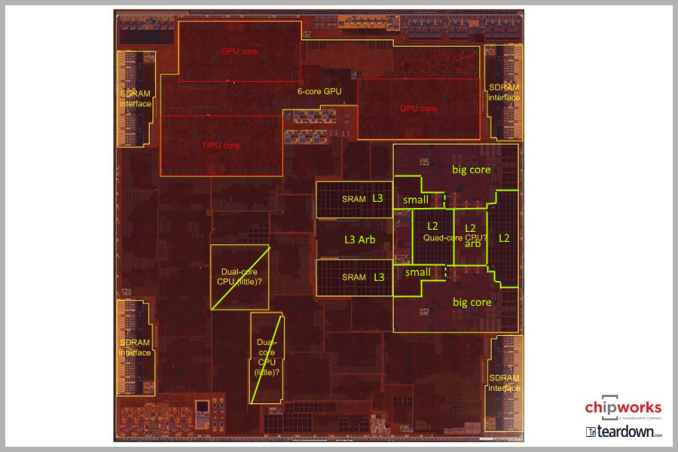
A10 Fusion's Floorplan (Special thanks to Chipworks)
While an in-depth look at A10 Fusion will have to wait until our seperate technology deep dive, we can still take a look at how performance has changed at a higher level. A10 Fusion's peak frequency is 2.3GHz, up from 1.8GHz on A9. This gives a theoretical improvement of 28% on its own, and the remainder will have to come from improvements to the architecture in Apple's (big) Hurricane cores. Based on our testing so far, Hurricane is not radically different from Twister (A9), but Apple has been making some optimizations. Meanwhile it should be noted that while A10 technically has four CPU cores – the two Hurricane cores and the two smaller cores – this is not a heterogeneous design, and only two cores are active at once. So for the purposes of high performance benchmarking, this means we're benchmarking the big cores nearly exclusively.
Anyhow, we've run our standard suite of benchmarks on the iPhone 7 and 7 Plus to see if A10 Fusion stands up Apple's performance claims.
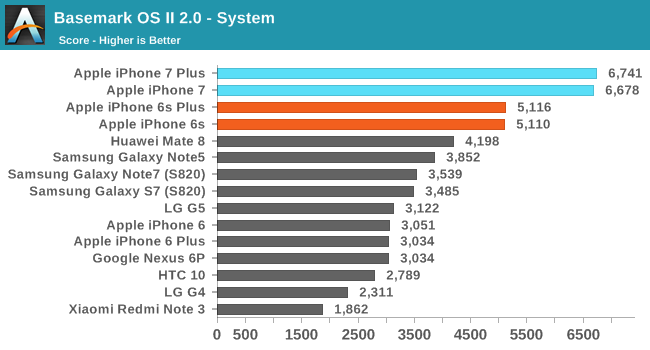
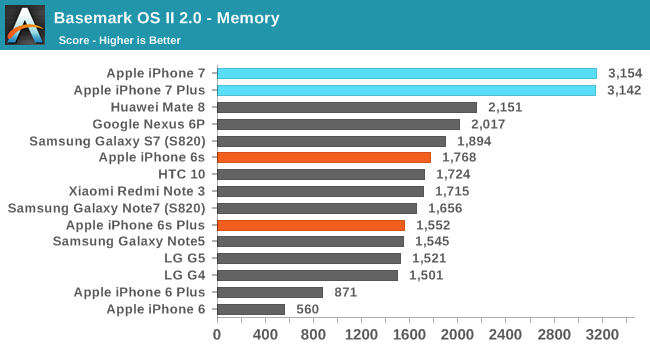
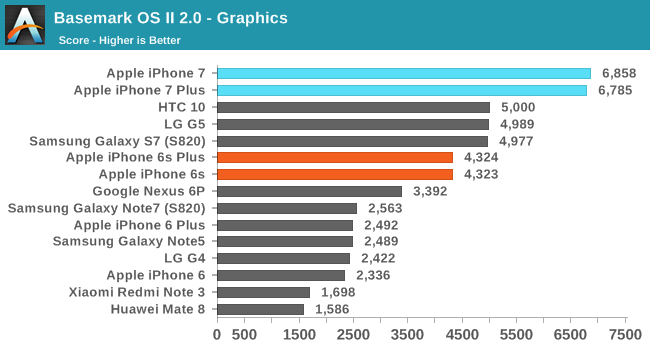
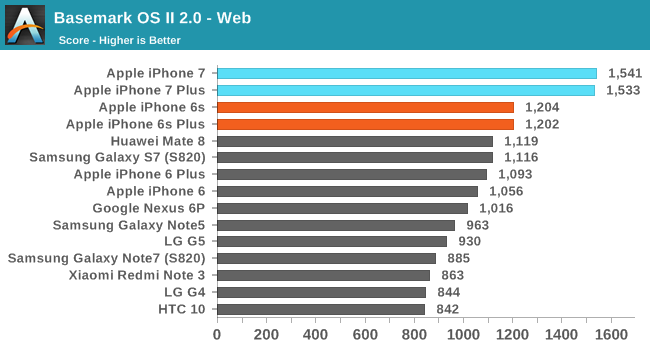

I've brought back BaseMark OS II for this review, although unfortunately the reason has less to do with wanting it back in the benchmark suite and more to do with there being very few cross-platform general system benchmarks nowadays. You can focus on the GPU, or the CPU, but the major system performance benchmark in mobile is PCMark and it remains exclusive to Android. BaseMark OS II is a pretty large optimization target now, and while it does test many aspects of the system it doesn't do so by directly simulating the tasks that a user would perform. Despite that, it helps in getting a holistic view of a device's performance by going beyond tests of a single component, so it's not without its uses.
The iPhone 6s and 6s Plus have remained the fastest overall devices in this test, so it's really just a matter of seeing how much Apple has improved. The latest generation of Android devices outpaced the GPU performance Apple's A9 SoC some time ago, so that's one area where Apple could stand to improve against the competition. As it turns out, they have. The iPhone 7 and 7 Plus show significant gains over their predecessors across the board. Performance in the system sub-test is up by 25-30%, and the graphics score is right in line with Apple's claimed 50% increase in performance. Web shows similar gains to system, which makes sense given that both are relatively CPU-bound.
The memory/storage test also shows a large improvement, which is interesting at first glance given that Apple didn't highlight any improvements in this area. However, this is just the result of the tested units being the 256GB model. On my retail iPhone 7 which is 128GB the memory score is essentially the same as the iPhone 6s which was also tested in a 128GB configuration. This comes down to the fact that these devices use a hybrid SLC/TLC storage solution, where the SLC storage can be used for writes and data can be moved later as needed. It's likely that on the 128GB iPhones the BaseMark OS II memory test is exceeding the size of the SLC cache, leading to lower scores based on the performance of the TLC NAND. On the 256GB iPhone the SLC cache is large enough to fit the entire data set used in the test, leading to a much higher score.
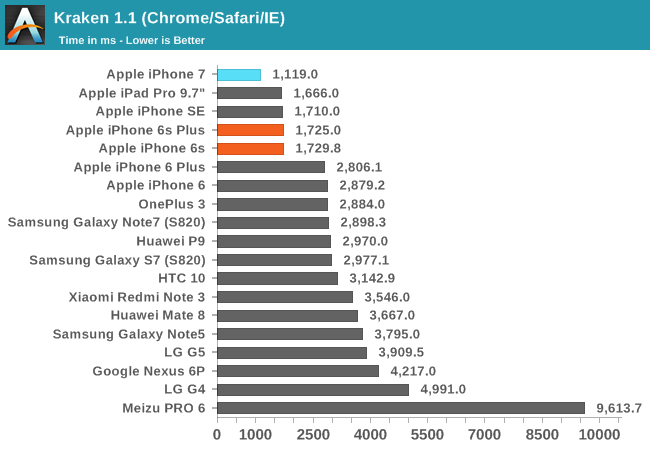
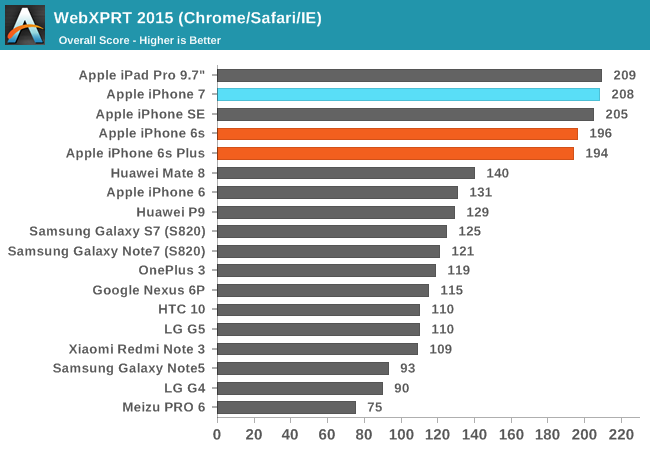
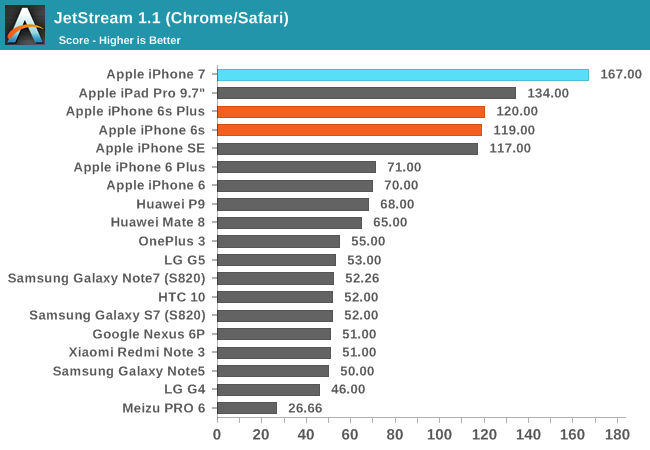
Web performance is an interesting case. While Apple's continued increases in single core CPU performance have benefited web performance with each generation, the truth is that improvements Mobile Safari's Nitro JavaScript engine have contributed a great deal as well. When looking at the charts you can see that there's a significant gap between the iPhone 7 and the next device, with the exception of WebXPRT where it's tied. What's more important than this gap is what the second device actually is. It's always another Apple device, and the same is true for the third device, and the fourth device, and so on. In Kraken and Jetstream the top seven devices on the chart are Apple's mobile devices, and the charts only have seven Apple devices in total. The Huawei Mate 8 is able to move ahead of the iPhone 6 in WebXPRT, but the gap between it and the iPhone 6s is still enormous. While Apple has continued to advance their web performance, it hasn't been with the immediate goal of beating the Android competition, as the best Android devices are still just trading blows with the iPhone 6.
WebXPRT is a small exception. As far as mobile benchmarks go, it's quite long and has short bursty workloads with pauses between each to simulate how a user would pause between different actions while using the browser. I suspect that in this case we're seeing the effects of A10 switching between its low power and high performance cores, causing parts of the test to be run on the little cores, which are not as performant. In fact, In the case of very quick actions that take only tenths or hundreths of a second to complete, it may not be possible to switch to the high performance cores before the operation has ended, causing the score to reflect the performance of the low power cores instead.
While it might seem reasonable to attribute the superior web performance of iOS devices to Apple's focus on improving single threaded CPU performance, the fact that Android devices with Cortex A72 CPUs are only matching Apple's A8 SoC shows that the gap is not only due to the CPU power available. Chrome's generally poor performance on Android is a significant limiting factor, and you can see in the chart how the improvement in Android device CPU performance over time has not translated into anything close to the sorts of gains that Apple has seen in the same period. While there are customized versions of Chromium like Snapdragon Browser that provide optimizations for a class of SoCs, it doesn't look like the gap between Android devices running Chrome and iOS devices running Mobile Safari is going to close any time soon, and if anything, it's only widening with each year.


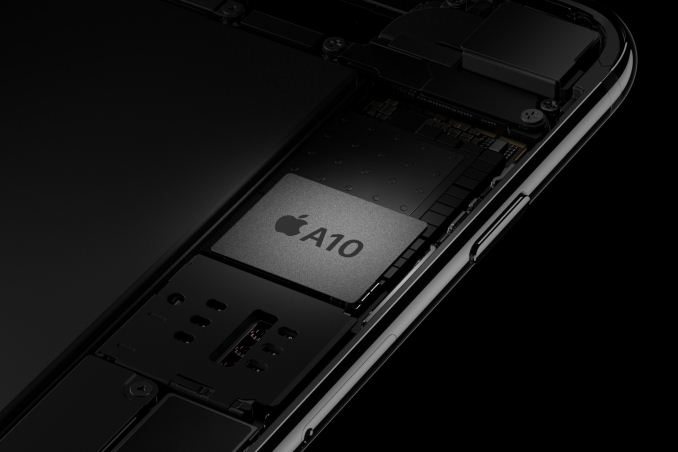








377 Comments
View All Comments
Fidelator - Monday, October 17, 2016 - link
Though it is worth noting that android OEMs really need better SoCs, for 4 product cycles Apple's SoCs have been vastly superior and nearly unmatched in most scenarios, with the 820 Qualcomm seems to have gone back to the right route but it's performance still leaves a lot of room for improvementMadaMadaDesu - Thursday, October 20, 2016 - link
"you could argue that the camera on the G5 provides superior, unmatched detail because it fits way more in the frame than any other camera providing more content and therefore more detail about the situation."If what you say is true, all professional photographers and others need is a single ultrawide lens? Why then, would the pros, especially a sports photographer, need a small army of super-telephotos that sometimes cost more than $10,000 each? Hey, just snap with an ultra wide, you captured way more!
Except sometimes you want a close up of a single ball player, not a picture of the 50,000 people in the stadium.
uceejay - Wednesday, October 19, 2016 - link
How much time it takes to charge iPhone 7 and 7 plus with 12W iPad adapter?tipoo - Wednesday, October 19, 2016 - link
What size iPhone did you test? GSMArena showed for one that the 128GB model is much faster, and two that the 32GB model is much slower at writeshttp://www.gsmarena.com/the_32gb_iphone_7_plus_use...
Harry_Wild - Monday, October 24, 2016 - link
Read most of the comments and it appears that the iPhone 7 is selling well based on the out of stock data! Just because it not technologically the best does not mean people have gave up buying it! It is a luxury item and most buyers do not think about it in theses terms. They just want it at Apple prices!bw13121 - Sunday, October 30, 2016 - link
I'm waiting for the Iphone 7 deep dive mentioned for release at the end of the month- that leaves today! Come on Anandtech, get this A10 dissecteddarwiniandude - Tuesday, November 1, 2016 - link
First page table is wrong in that the 56mm f2.8 is not OIShassanmm - Wednesday, November 9, 2016 - link
Brand new Original Apple iphone 7 and 7 plus cost 650usd with 1year warranty.Serious buyer should contant us.
Whatsapp CHAT or Call : +447405502988 or 00447405502988
Vanguy79 - Friday, November 18, 2016 - link
They can afford a deep dive for Google pixel phone but not for iPhone 7?douglerner - Saturday, November 19, 2016 - link
I find my new iPhone 7 Plus display noticeably dimmer and "dingier" than my iPhone 6 Plus display in all lighting situations. I went to exchange and the exchange unit was even dimmer. Currently Apple is "looking into it" and were supposed to get back to me by the end of the week. Generally I like the phone features and speed. But the fact the screen is not as advertised and is, in fact, dimmer than my iPhone 6 Plus irks me.You can see more details and my side-by-side photos at https://discussions.apple.com/thread/7744754